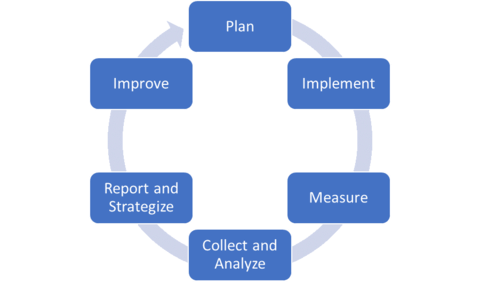The Howard Annual Assessment Process (HAAP)
The university-wide assessment process at Howard University is called the Howard Annual Assessment Process (HAAP).
The HAAP Cycle
The assessment cycle is a closed loop of planning, implementing, measuring, collecting and analyzing, reporting and strategizing, improving, and then planning again. The cycle is closed by departments’ and units’ use of data for continuous improvement. Assessment is an ongoing activity with different benchmarks that allow units to debrief, discuss, and redirect their efforts toward more effective use of resources to meet unit goals.
Click Here for a Basic Guide to HAAP Planning
Assessment Connections
The Howard Annual Assessment Process is an anchor to a variety of assessment-related activities at Howard which all have the ultimate goal of continuous improvement. HAAP plans serve three inter-related purposes:
1) Annual assessment activities help units continuously improve and track the degree to which improvements contribute to unit success.
2) Annual assessment plans constitute evidence that institutions are working towards institutional effectiveness for regional and discipline-specific accreditors.
3) Annual assessment plans help units make data-driven decisions and support resource requests and annual reports to administration.
What should an Assessment Plan do?
According to Linda Suskie, a vice president of the Middle States Commission on Higher Education and author of Assessing Student Learning: A Common Sense Guide, every assessment plan should tell a story that answers the following questions:
- How do you define a successful student?
- What’s the evidence that students meet your definition of success?
- Are you satisfied with your results? Why or why not?
- If you’re not satisfied, what could be the cause and what are you going to do about it?
Frequently Asked Questions about HAAP
What is an assessment plan?
Assessment plans contain a mission, a set of outcomes, measures, targets, findings, and reflection on how those findings will be used to improve the program.
What is the HAAP process?
All academic programs (degrees, certificates, and “orphan” minors) should produce an assessment plan based on assessing student learning outcomes. All administrative units (non-instructional and academic administrative units (departments, schools, and colleges) should produce a plan built on assessing operational objectives. These annual reports will serve as the basis of the HAAP.
When is my HAAP plan due?
Plans are to be submitted annually and determined by the assessment team. Please refer to the assessment calendar to see where we are in the current assessment cycle.
What is the process of submitting the plan?
Units should plan an assessment strategy based on program learning outcomes or unit objectives. Each annual plan does not need to capture all dimensions of the program or unit but should create a measurable and meaningful process for assessing the unit’s ability to meet its goals. The plans will be entered into the Planning and Self-Study platform and reviewed by Institutional Research and Assessment for completeness. If measurement methods are inappropriate, authors will be consulted and asked to resubmit. Once accepted, the plan will be implemented, and data will be gathered. Units will then report the results of their assessment and make recommendations for improvement based on these results.
What are best practices for submitting the plan (academic)?
- Plans should rely on direct measures (faculty or industry experts assessing students’ ability to meet a student learning outcome).
- Plans can include indirect measures (students assessing their own ability to meet an outcome), but this should be done only to support direct assessments.
- Course grades (final grade submitted for a course) should not be used as an assessment measure as it is not granular enough to be useful.
- Plans should focus on “end-of-program” experiences or activities (capstone courses, comprehensive exams, defenses, final projects, etc.).
- Programs with assessment plans already in place (particularly those related to discipline-specific accreditation) should use those measures as part of their assessment cycle. There is no need to “re-invent the wheel.”
What are best practices for submitting the plan (non-instructional)?
- Plans should be focused on data streams that are already collected by the units.
- Plans should be directly linked to the objectives of the unit.
- Units should only measure things that they can control (ex: Admissions may assess the “turn-around time” for an application to be processed, but they would not assess how many applications they receive if they are not directly involved in recruitment.
- Measures must be measurable and meaningful.
- Measures should try to include “client-facing” measures like customer satisfaction.

